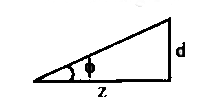The human eye has an approximate angular resolution of ϕ=5.8×10−4 rad and a typical photo printer prints a minimum of 300 dpi (dots per inch, =2.54cm). Aminimum distance 'z' should a printed page be held so that one doesnot see the indivdual dots is ______ .
17 cm
12.5 cm
14.5 cm
16.3 cm
The correct Answer is:C
The printer prints 300 dots per inch.
∴ The linear distance between two dots=d
=2.54300cm=0.84×10−2cm
At a distance of z cm, this distance subtends an angle ϕ.
∵tanϕ=ϕ=dz

∴z=dϕ=0.84×10−25.8×10−4=845.8=14.5cm
Topper's Solved these Questions
- INTERFERENCE AND DIFFRACTIONBOOK - MARVEL PUBLICATIONCHAPTER - INTERFERENCE AND DIFFRACTIONEXERCISE - TEST YOUR GRASP
20 Videos
- GRAVITATION BOOK - MARVEL PUBLICATIONCHAPTER - GRAVITATION EXERCISE - TEST YOUR GRASP -2
20 Videos
- KINETIC THEORY OF GASES ,THERMODYNAMICS AND RADIATIONBOOK - MARVEL PUBLICATIONCHAPTER - KINETIC THEORY OF GASES ,THERMODYNAMICS AND RADIATIONEXERCISE - TEST YOUR GRASP - 9
30 Videos
Similar Questions
The human eye has an approximate angular resolution of ϕ=5.8×10−4 rad and a typical photo printer prints a minimum of 300 dpi (dots per inch, =2.54cm). Aminimum distance 'z' should a printed page be held so that one doesnot see the indivdual dots is ______ .
View SolutionTwo metalic plates A and b has the same area of 5×10−4m2 are placed parallel to each other at a distance of 1 cm. Plate B carrins a positive charge of 33.7×10−12C. A monochromatic beam of light, with photons of energy 5eV each, starts falling on plate A at t=0 so that 1016 photons fell on it per square metre per second. Assume that one photoelectron is being emitted for every 106 incident photons. Assuming that all the emitted photoelectrons are collected by plate b and th work function of plat A remains constant at the value 2 eV, the numbeer of photoelectrons emitted up to t=10 s is n×106. Find the value of n.
Negleect the time taken by the photoelectron to reach plate B.
(Take ε0=8.85×10−12C2N−m2)
View SolutionTwo metallic plate A and B , each of area 5×10−4m2, are placed parallel to each at a separation of 1cm plate B carries a positive charge of 33.7×10−12C A monocharonatic beam of light , with photoes of energy 5eV each , starts falling on plate A at t=0 so that 1016 photons fall on it per sqare mater for every 106 incident photons fall on it per square meter per second Assume that one photoelectron is emitted for every 106 incident photons . Also assume that all the emitted photoelectron are collected by plate B and the work function of plate A remain constant at the value 2eV Determine
(a) the number of photoelectrons emitted up to i=10s,
(b) the magnitude of the electron field between the plate A and B at i=10s,and
(c ) the kinetic energy of the most energotic photoelectrons emitted at i=10s whenit reaches plate B
Negilect the time taken by the photoelectrons to reach plate BTakeε0=8.85×10−12C2N−m2)
View SolutionA mercury arc lamp provides 0.10 W of UV radiation at a wavelength of λ=2537Å(all other wavelenghts having been absorbed by filters). The cathode of photoelectric device (a photo-tube) consists of potassium and has an effective area of 4cm2. The anode is located at a distance of 1 m from radiation source. The work function for potassium is ϕ0=2.22eV.
(a) According to classical theory, the radiation from the arc spreads out uniformly in space as spherical wave. What time of exposure to the radiation should be required for a potassium atoms(radius 2 Å) in the anode to accumulate sufficient energy to eject a photo-electron?
(b) What is the energy of a single photon from the source?
(C) What is the flux of photons(number per second) at the cathode? To what saturation current does this flux correspond if the photo-conversion efficiency is 5% (i.e. if each photon has a probability of 0.05 of ejecting an electron).
(d) what is the cutt off potential V0?
View Solution
